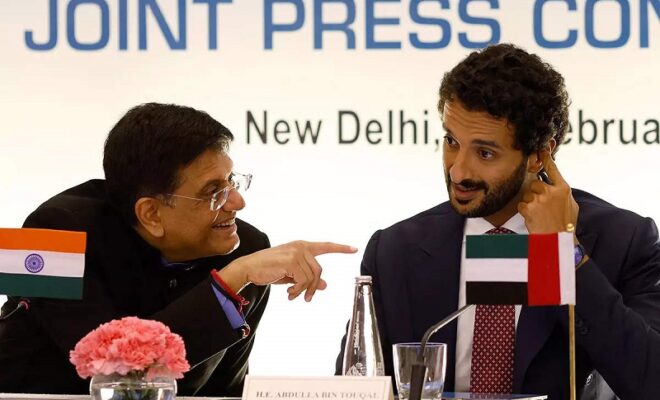India and UAE sign landmark free trade pact, aim for $100 bn in annual trade

Last updated on March 10th, 2022 at 04:28 am
India and United Arab Emirates (UAE) have signed a milestone pact, free trade agreement (FTA) on Friday aiming to bolster bilateral trade and economic ties and eyeing $100 billion in annual trade.
The agreement that is being called the Comprehensive Economic Partnership Agreement (CEPA) is signed by Commerce and Industry Minister Piyush Goyal and UAE Minister of Economy Abdulla bin Touq Al Marri. On Friday, Indian Prime Minister Shri Narendra Modi and Crown Prince of Abu Dhabi HH Sheikh Mohammed bin Zayed Al Nahyan held a virtual summit wherein they expressed their gratitude at continuing growth of bilateral relations between the two nations across multiple sectors.
Read More: India-UAE Bilateral Relation & Economic cooperation
Prime Minister Modi later tweeted announcing signing of the pact. He wrote on Twitter, “Great pleasure to hold Virtual Summit with my friend HH @MohamedBinZayed Crown Prince of Abu Dhabi. India-UAE comprehensive strategic partnership has undergone huge transformation in the past 7 years. We issued a Joint Vision Statement that lays the future roadmap for our ties.” He continued, “HH @MohamedBinZayed
Related Posts
and I believe that the India-UAE CEPA signed today will be a game-changer in our economic ties. With enhanced market access, bilateral trade in goods should rise to $100 billion and services to $15 billion in the next 5 years.”
Read More: India & UAE: Cultural ties reaching new horizons
Sources say that the CEPA between India and UAE will help opening new avenues of trade routes between Asia and Africa. Through this Indian exporters will gain wider access to UAE market and also Arab and African markets. Under this agreement, UAE has offered to immediately remove 80 per cent of its tariffs corresponding to 90 per cent of exports from India to West Asian countries in terms of value.
This deal will particularly bring in gains in labor intensive industries in India like gems and jewellery, textiles, leather, footwear, sports goods, plastics, furniture, agricultural and wood products, engineering products, pharmaceuticals and medical devices as well as automobiles.



